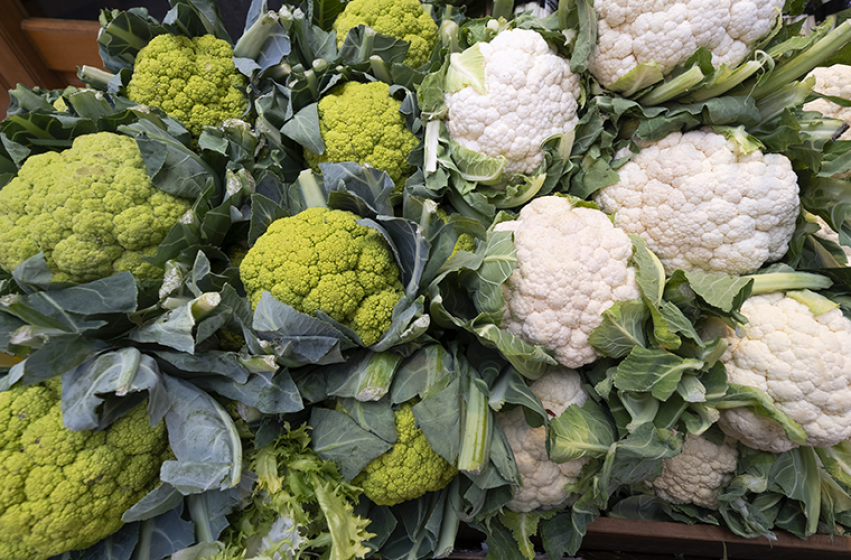Cole crops are a group of cool season vegetables that belong to the mustard (Brassica) family and are all descendants of wild cabbage. As a group, these plants grow better in cool weather. Some people think that the word “cole” is a variant of the word “cold” and may even refer to these plants as cold crops. Many of the vegetables in this group allow you to eat all or a portion of the stem (the word “cole” is a variation of a Latin word that means stem). Cole crops include brussels sprouts, cauliflower, cabbage, broccoli, kale, mustard and collards.
WHEN TO PLANT
Planting in the proper season is the first step to a bountiful garden. Cole Crops grow best in spring & fall and can tolerate some frost, but do not grow well in hot weather. Most cole crop gardeners grow from spring transplants, although fall crops may be seeded directly into garden in early summer. When planted in the spring, you’ll be able to harvest them in early-to-mid-summer.
TIP: With a little advanced planning, you can enjoy a harvest from two gardens with just one garden plot. By planting both spring and fall cole crops, you’ll have a continual source of vegetables in both spring and fall.
WHERE TO PLANT
Cole crops can be planted just about anywhere in the garden, as long as they receive six to eight hours of sun each day. However, due to their need for cooler temperatures, they’ll do fine in a moderately shaded garden. Additionally, if you live in an area that has a brief cool season, planting them in part-shade can help alleviate daytime temperatures by keeping direct sun from shining down on plants.
FEEDING
Cole crops require careful nutrient management to obtain good quality and maximum yields. They are sensitive to several micro-nutrient deficiencies and require nitrogen throughout the growing season. Therefore, it is important to add both organic material and a quality fertilizer in the beds you plan on growing cole crops prior to planting. For feeding, we recommend the following:
- McDonald Greenleaf (traditional or organic formulas) - 12-4-8 slow release formula that gives an excellent initial feed you will see within days and continues to feed for 1-3 months depending on plant needs. All plant food has macro-nutrients, Nitrogen-Phosphorus Potassium, but Greenleaf has micro nutrients, including boron, copper, iron, magnesium, zinc and molybdenum to help increase the nutrients that soil naturally lacks.
- Espoma Garden Tone - is a premium plant food formulated specifically for herb and vegetable gardens. It is made from natural and organic plant food ingredients and contains no sludges or fillers. The organics in Garden-tone break down gradually to provide a safe, long lasting food reservoir for plants and flowers throughout the growing season.
- Bio-Tone Starter Plus - is an all natural plant food enhanced with bio-stimulants, beneficial bacteria, and mycorrhizae. Bio-Tone works naturally within the soil to help plants establish quickly, withstand environmental stress, promote deeper root systems, encourage better blooms, and improve soil structure.
CROP ROTATION
Crop rotation involves changing the planting location of vegetables in the garden each season. Rotation helps to reduce damage from insect pests, limit the development of diseases, and helps keep your soil healthy and fertile.
WATERING
Make sure your cole crops stay moist and receive a steady supply of water. They need about one inch of water per week.
MULCHING
Mulching around your garden vegetables prevents weeds, keeps the soil cool (or warm in the cooler months), and helps retain moisture in the ground around your plants.
HARVESTING
“Use them or lose them” Once your vegetables are growing, be sure to harvest and pick your veggies often. To obtain the highest quality produce harvest crops as follows:
- Brussels Sprouts - As sprouts enlarge, remove large leaves between sprouts. Pinch out growing tip of plants to accelerate maturity. Harvest sprouts when firm & before they open up. Light frost improves flavor.
- Cauliflower- When heads reach diameter 5-8 inches and before segments begin to separate. To get pure white heads, exclude light. Tie outer leaves over the developing head with rubber bands and keep them tied until harvest
- Cabbage - When head is very firm.
- Broccoli - Harvest while head is still compact and before small flower buds open to show yellow.
- Kale & Collards - Harvest any time leaves are large enough for intended us. Tender young leaves are best for salad, while older leaves are best for cooking. Frost improves flavor.
Did you know that, while sold and grown at the same time as cole crops, lettuce, Swiss chard, spinach, beets, arugula and Pac choi are considered leafy vegetables and not cole crops? To learn more about cole crops visit the Virginia Cooperative Extension link, click here.

